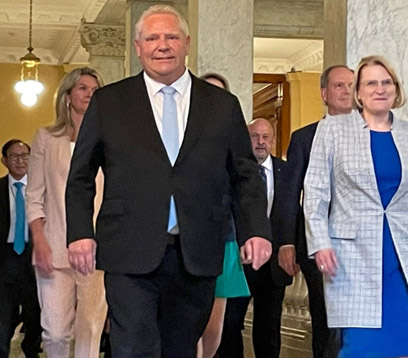Doug Ford’s mid-2024 shuffle brings “the largest cabinet in Ontario’s history”!!
Jun 18th, 2024 | By Randall White | Category: In BriefRANDALL WHITE, ONTARIO TONITE, TORONTO . TUESDAY, JUNE 18, 2024. The somewhat bizarre recent Ontario cabinet shuffle, “shortly after the Ontario Legislature ended for an extended summer break,” might be viewed as proof that Premier Doug Ford really is in some ways quite a lot like Donald Trump in the USA .
Whatever else, the current leader of the Ford Nation does not altogether accept (let alone know about?) the conventions and practices by which Canada’s most populous province has been soberly and sometimes even wisely (if also too often boringly) governed, since the long founding regime of the Oliver Mowat regionalist Liberals in the later 19th century (1872–1896, to be somewhat more exact).

So (it might equally be said) in his almost humourous cabinet shuffle of June 6, 2024 Premier Ford has knowingly or otherwise altogether set aside the conventions of executive government on the Westminster parliamentary democratic model — as evolved in the United Kingdom from, say, the late 17th to the late 19th centuries, and embraced with quiet colonial enthusiasm by Premier Mowat and his successors in Ontario, more or less all the way down to Premier Wynne.
And so also, as explained by Colin D’Mello and Isaac Callan at Global News, the June 6, 2024 “cabinet shuffle at Queen’s Park … resulted in the largest cabinet in Ontario’s history… While the shuffle meant some ministers swapping portfolios and fresh faces being added to the cabinet table in newly-created positions, Ford didn’t remove a single minister during reorganization … The result: 36 ministers and associate ministers … up from 20 in 2018,” when the present Ontario Ford Nation government began.
Historical trends in cabinet growth in Canada and Ontario

It can of course be said that even a historically large Ontario provincial cabinet of “36 ministers and associate ministers” remains somewhat smaller than PM Justin Trudeau’s current federal cabinet in Ottawa.
And, as explained by the relevant online Canadian Encyclopedia article : “The federal Cabinet consists of Members of Parliament … appointed by the prime minister to head major government departments. With the expansion of government activity, cabinets have increased in size from the original 12 to a high of 40 members (under Prime Minister Brian Mulroney in September 1987). Downsizing reforms somewhat reversed this growth. (Prime Minister Jean Chrétien’s Cabinet in January 1996 had 25 members.) However, in July 2013, Prime Minister Stephen Harper led a Cabinet of 39 members.”

Provincial cabinets in Ontario, it might be added, also started out considerably smaller than “the original 12” in Ottawa. Oliver Mowat’s first cabinet in Toronto had only five members, including himself. On the eve of the First World War in 1914 the Ontario cabinet (now under the Conservatives James Whitney and later in 1914 William Hearst) had increased to eight members. One hundred years later again : “In 2014, the average size of the provincial cabinets was 18 members. Ontario and Quebec were the largest with 27; PEI was the smallest with 11.”
In parliamentary democracies everywhere cabinet sizes increased almost dramatically as the size and role of government generally increased almost dramatically in the 20th century. And in virtually all cases as well the old ideal of the prime or first minister or premier as merely primus inter pares (“first among equals”) in the cabinets he or she appoints, has given way to various present-day traditions of “prime ministerial dominance.”
Doug Ford and the commanding heights of prime ministerial dominance in Canada 2024
Numbers do seem to count here too. A cabinet of even as many as 20 individuals, as the Ford Nation started with in Ontario in 2018, may be able to more or less make collective decisions, where the first minister just aspires to the at least theoretical status of first among equals — if not altogether as easily as cabinets of from eight to 12 members.
In a cabinet with as many as 36 members the more bureaucratic office of the first minister is probably bound to assume more of a co-ordinating role, outside formal cabinet meetings. And this leads to a more centralizing and commanding role as leader for the first minister (who does appoint the cabinet ministers to start with).
A perhaps increasingly extreme version of this same general trend may help explain why many who do business with the Ontario government today assume that almost all important decisions are made by Premier Ford, and merely implemented by his cabinet ministers. (Insofar as such a thing is possible in the highly complex, diverse, and far-reaching public enterprise that is the Ontario government of the 21st century.)
In any case some of we the people of Ontario have already grown weary of Ontario Conservative (or as they say “PC”) TV commercials, that are all hagiopgraphic stories about Premier Ford.
At the same time, we are happily watching news clips featuring such attractive federal cabinet ministers as Melanie Joly (while hearing nothing at all from PM Justin Trudeau — current “dean of the G7,” someone recently explained on X).
We might be pardoned for imagining that the commanding heights of prime ministerial dominance in Canada may now reside in the office of the premier of its most populous province.
Meanwhile, Doug Ford’s somewhat bizarre largest cabinet in Ontario history of 2024 does somehow fit the MPP from Etobicoke North, who in 2022’s provincial election with the lowest voter turnout in Ontario history (44%) won a tidy majority of seats in the legislature with not quite 41% of the province-wide popular vote.
The premier equally does appear to think, as do his close advisors, that the Ontario government is first and foremost all about him! And this finally takes us all the way back to what might be viewed as yet more proof (well … evidence at least) that Premier Doug Ford really is in some respects quite a lot like Donald Trump in the USA today (but hopefully not tomorrow too).




